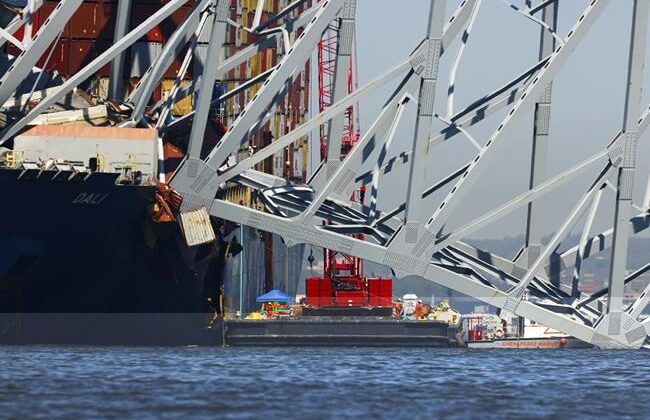
New data shows which Ports gained from Baltimore’s losses after bridge collapse
BALTIMORE : The Port of Baltimore experienced its worst month in more than 20 years, according to my analysis of tonnage data for April released this week by the U.S. Census Bureau, its sixth worst by value.
That it handled any exports and imports at all in the first full month since the container ship Dali struck and destroyed the main span of the Francis Scott Key Bridge leading to the Baltimore port is impressive in it own right.
But it definitely pushed the Port of Baltimore, one of the nation’s fastest-growing seaports in recent years, off course, despite great progress subsequently in creating pathways for ships.
It had finished 2023 as the the No.8-ranked port by tonnage and No. 18 by value when compared to more than 450 U.S. airports, seaports and border crossings.
It was the nation’s most important port for a wide variety of exports and imports, particularly in the areas of passenger vehicles and heavy construction equipment, and perhaps will be so again.
Here’s the gravity of the damage to port business:
For the month of April, exports fell 81.28% when compared to March and 85.55% when compared to the previous April. By tonnage, those declines were 76.99% when compared to March and 75.54% when compared to the previous April. By value, overall trade was off $5.22 billion, when compared to the previous April, a better performance than the $6.5 billion I had predicted in the immediate aftermath of the bridge collapse. (Which is why I try to stick to predicting the past rather than the future.)
What happened to all those exports and imports?
For this article, I focused on imports, since the Port of Baltimore, like so many U.S. seaports, is dominated by imports, and just a few key ones at that.
What appears to be the case is those leading Port of Baltimore imports prior to the bridge collapse found their way, depending on the import, to the Port of Newark, the Port of Virginia, the Port of Charleston, the Port of Savannah and the Port of Brunswick.
The most valuable import both in March and the previous April was passenger vehicles. The $775.11 million decline from the previous month was four times the value of the second most serious import decline but a relatively less severe though still painful percentage decline of 39.62%.
The Port of Brunswick, which I predicted might get the lion’s share of those imports, gained a nearly identical 39.63%. That’s a difference of $611.89 million. A neighboring port, the Port of Jacksonville added $258.03 million and Newark added 233.64 million.
Ranked first in the nation in March, the Port of Baltimore fell to sixth in April. Brunswick replaced it in the No. 1 spot, recording its first ever month with imports worth more than $2 billion. Overall, U.S. auto imports increased 10.83% in the month of April.
The second-most valuable Port of Baltimore import in March, self-propelled construction equipment, fell $166.80 million when compared to March. That was equal to a 76.35% drop, a drop slightly larger than that for overall imports.
The Port of Baltimore led the nation in this category in March as well. In April, it ranked seventh. Most of the Baltimore imports in this category, which includes bulldozers and front-end loaders, in March were excavators that sit on a platform that can rotate 360 degrees.
As was the case with passenger vehicle imports, it was a good month nationally when compared to March, with the value increasing $115.59 million, an increase of 11.96%.
At the Port of Baltimore, the decrease was $166.80 million, a decline of 76.35%.The big gainers here appear to be the Port of Virginia (up $88.91 million, 126.12%), Port of Savannah ($54.03 million, 27.70%) and Newark ($43.43 million, 258.09%).
With regard to unwrought aluminum, the Port of Baltimore ranked second only to Port Huron, Mich., in the month of March. In April, it dropped behind another 11 to rank No. 13. Nationally, imports of aluminum, an item subjected to tariffs in the Trump and Biden administrations, surged 25.57% in value, gaining $187.95 million in value.
At the Port of Baltimore, the value of imports fell $99.97 million, a decrease equal to 88.14%. This one is a little more difficult to suss out but it appears the likely alternative to Baltimore included the Port of Newark (up $69.41 million, 233.24%) and possibly the Port of Savannah ($10.24 million, 100.09%).

Author : Ken Roberts
